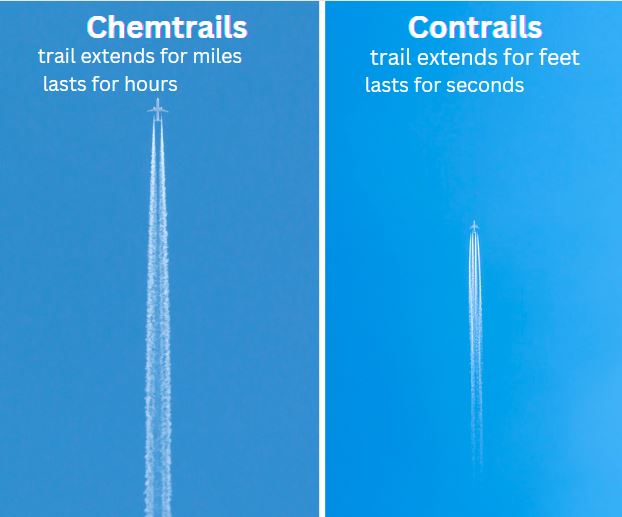Contrails vs. Chemtrails: Understanding the Differences
The sky is often crisscrossed with white streaks left by high-flying aircraft. These trails, while familiar to many, have sparked both scientific explanations and conspiracy theories. The terms “contrails” and “chemtrails” refer to these phenomena, but they describe vastly different concepts. Here, we explore the differences between contrails and chemtrails, delving into their origins, appearances, and the scientific consensus surrounding them.
Contrails: The Science Behind the Streaks
Definition and Formation: Contrails, short for condensation trails, are clouds of ice crystals or water vapor created by aircraft engine exhaust or atmospheric pressure changes. When an aircraft flies at high altitudes, typically above 26,000 feet, the hot, humid air from the engine exhaust mixes with the cold, low-pressure air. This rapid cooling causes the water vapor in the exhaust to condense and freeze, forming ice crystals. These ice crystals then appear as white streaks in the sky.
Appearance and Behavior: Contrails usually manifest as long, thin, white lines that can vary in length and thickness. Their behavior and duration depend largely on atmospheric conditions such as humidity and temperature. In dry conditions, contrails may dissipate quickly, vanishing within minutes. However, in more humid conditions, they can linger for hours, gradually spreading out to form cirrus clouds.
Scientific Explanation: The formation of contrails is a well-understood phenomenon in atmospheric science. It involves basic principles of condensation and freezing in the upper atmosphere. The primary constituents of contrails are water vapor and ice, with minor amounts of carbon dioxide, soot, and metal particles from the jet fuel. These trails are considered a normal and harmless byproduct of aviation.

Chemtrails: The Conspiracy Theory
Definition and Claims: The term “chemtrails” arises from a conspiracy theory suggesting that some aircraft trails are not mere condensation but chemical or biological agents deliberately sprayed for undisclosed and often nefarious purposes. Proponents of the chemtrail theory believe these trails contain harmful substances and are part of secret government programs aimed at weather modification, population control, or other sinister activities.
Appearance and Misinterpretation: Chemtrails are purported to look similar to contrails but are claimed to linger longer, spread more widely, and form suspicious patterns. Conspiracy theorists argue that these characteristics indicate the presence of chemicals. However, the same features can be explained by atmospheric conditions affecting contrail behavior.
Lack of Scientific Evidence: The scientific community widely dismisses the chemtrail theory due to a lack of empirical evidence. Studies have consistently shown that trails attributed to chemtrails are chemically indistinguishable from regular contrails. The composition of these trails aligns with what is expected from jet engine emissions: primarily water vapor, carbon dioxide, and trace amounts of soot and metal particles.
Key Differences: Contrails vs. Chemtrails
Origin and Purpose:
- Contrails: Naturally occurring byproducts of aircraft flying at high altitudes, explained by condensation and freezing processes.
- Chemtrails: Alleged deliberate releases of chemicals, based on conspiracy theories without scientific backing.
Scientific Basis:
- Contrails: Supported by atmospheric science, with well-documented formation mechanisms.
- Chemtrails: Lacks scientific evidence, widely regarded as a conspiracy theory.
Public Perception:
- Contrails: Generally accepted as harmless and normal.
- Chemtrails: A subject of controversy, primarily among conspiracy theorists.
Conclusion
Understanding the difference between contrails and chemtrails is crucial in dispelling myths and fostering informed discussions about aviation and atmospheric science. Contrails are a scientifically explained phenomenon resulting from aircraft engine exhaust and atmospheric conditions. In contrast, chemtrails are part of a conspiracy theory lacking evidence and scientific support. Recognizing these distinctions helps in addressing misconceptions and appreciating the natural processes at play in our skies.
 Electrical Engineering World Wiring a Brighter Tomorrow!
Electrical Engineering World Wiring a Brighter Tomorrow!